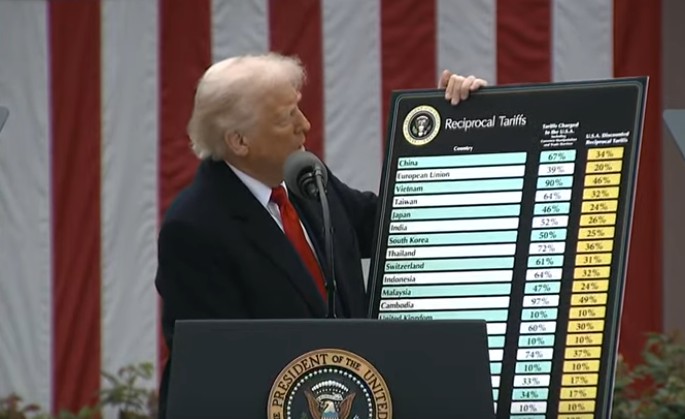After decades of watching American manufacturing decline and trade deficits balloon, President Donald Trump has finally taken bold action to level the playing field. His “Liberation Day” announcement of reciprocal tariffs represents a fundamental reset of America’s trade relationships – one that’s been desperately needed.
The Reciprocal Tariff Plan: What It Means
Yesterday, President Trump signed a sweeping executive order implementing new tariffs on virtually all imports to the United States. The plan establishes a baseline 10% tariff on all imports starting April 5th, with higher “reciprocal” rates for countries that have maintained unfair trade practices against American goods, taking effect April 9th These rates were calculated based on the trade imbalances each country has with the US – with Trump explaining they would charge trading partners “approximately half of what they are and have been charging us.”
Some countries face significantly steeper rates due to their persistent trade surpluses with America. China, already subject to a 20% tariff, will now face a staggering 54% total tariff rate. The European Union will see a 20% tariff, Japan 24%, Vietnam 46%, and Taiwan 32%. These rates reflect years of unbalanced trade relationships.
The Real Cost of “Free Trade”
For too long, America has maintained one of the most open markets in the world while our trading partners erected significant barriers against our products. As President Trump declared during his Rose Garden announcement, this action represents “a declaration of economic independence” and a rejection of America’s “unilateral economic surrender.”
According to the executive order signed yesterday, the United States has among the lowest average tariff rates in the world at just 3.3%, while many of our trading partners impose much higher rates: Brazil (11.2%), China (7.5%), the European Union (5%), India (17%), and Vietnam (9.4%). This fundamental imbalance has led to the hollowing out of our manufacturing base and created a staggering annual trade deficit of $1.2 trillion in 2024.
The consequences have been devastating for American workers and communities. Since 1997, the United States has lost approximately 5 million manufacturing jobs, one of the largest drops in manufacturing employment in our history. This decline has concentrated in specific geographical areas, contributing to social troubles including the opioid crisis and declining family formation.
One-Way Street: The Auto Industry Example
Perhaps no example better illustrates the unbalanced nature of global trade than the automotive industry. Try finding an American car on the streets of Tokyo or Seoul – they’re practically non-existent. Yet Japanese and Korean vehicles flood American roads.
As outlined in the executive order, the United States imposes just a 2.5% tariff on imported passenger vehicles, while the European Union (10%), India (70%), and China (15%) charge substantially higher rates for the same product. Similar disparities exist across countless products and industries.
This isn’t just about tariff rates. Non-tariff barriers – complex regulations, licensing requirements, and other obstacles – have made it nearly impossible for many American products to gain fair access to foreign markets. The 2025 National Trade Estimate Report on Foreign Trade Barriers details numerous non-tariff barriers to U.S. exports worldwide, ranging from import restrictions to inadequate intellectual property protections to discriminatory practices against American digital products.
National Security Implications
Beyond the economic impact, our trade imbalances pose serious national security concerns. According to the executive order, the persistent decline in U.S. manufacturing output has reduced our manufacturing capacity, especially in critical sectors like automobiles, shipbuilding, pharmaceuticals, technology products, and basic metals – areas where, once lost, production capacity becomes nearly impossible to restore.
The COVID-19 pandemic exposed our vulnerability when Americans struggled to access essential products. The recent attacks on shipping by Houthi rebels further demonstrated the fragility of global supply chains. We simply cannot be dependent on foreign nations, including potential adversaries, for critical goods.
Not a Tax on Americans, But an Investment in Our Future
Critics will claim these tariffs are just taxes on American consumers. What they fail to acknowledge is the long-term cost of doing nothing – continued manufacturing decline, job losses, community devastation, and increasing national security vulnerabilities.
Manufacturing remains the engine of American innovation, accounting for 55% of all patents and 70% of research and development spending. Every manufacturing job creates 7 to 12 new jobs in related industries. By revitalizing our manufacturing base, we’re investing in future prosperity.
While prices may increase in the short term, the long-term benefits of restoring American manufacturing capacity far outweigh the costs. As domestic production increases, competition will grow and prices will stabilize. More importantly, the money Americans spend will stay in our communities rather than flowing overseas.
A New Path Forward
President Trump has demonstrated the courage to challenge a status quo that has failed American workers for decades. These reciprocal tariffs send a clear message to our trading partners: America will no longer accept unfair, one-sided trade relationships.
The plan includes flexibility for trading partners willing to correct their unfair practices. According to Section 4(c) of the executive order, “Should any trading partner take significant steps to remedy non-reciprocal trade arrangements and align sufficiently with the United States on economic and national security matters, I may further modify the HTSUS to decrease or limit in scope the duties imposed under this order.”
The objective isn’t to start a trade war but to finally establish genuine reciprocity – the principle that has historically guided American trade policy but has been abandoned in practice. After decades of watching American factories close and jobs disappear while our trading partners prospered through unbalanced relationships, it’s about time someone stood up for American workers.
For too long, we’ve been told that globalization and free trade benefit everyone equally. The empty factories and struggling communities across America tell a different story. Yesterday’s “Liberation Day” marks the beginning of a new era in American trade policy – one that puts American workers and American interests first.
Disclaimer: This opinion piece represents the views of the author and not necessarily those of this publication. The economic impact of tariffs is complex and multifaceted. While this article presents arguments in favor of the tariff policy, readers should be aware that many economists have expressed concerns about potential negative consequences including higher consumer prices, retaliatory measures from trading partners, and global economic slowdown. The information presented is based on official statements and reporting as of April 3, 2025, and may be subject to change as policy implementation evolves.




